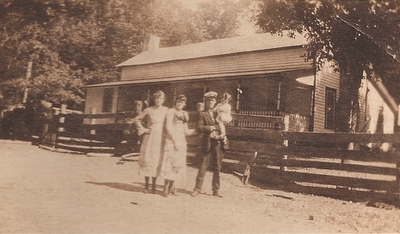Just a few
new things—None of them are big enough on their own to merit an entire post,
but I’m pretty excited about all of them.
·
I found a
new Roberts cousin on Family Tree DNA!
With all the confusion about the Huff and/or Pharris DNA and who may
have been Elzina Huff’s parents, it was nice to have a definitive match with a
Roberts relative. In previous posts I
wrote that I was pretty sure that Stephen Roberts had a brother Caleb, who in
turn had a son James K. “Polk” Roberts.
Well, it has now been proved by DNA.
Polk Roberts moved to Hughes County, Oklahoma, near his Roberts
cousins, Cornelia and James Nathan, and is buried in Holdenville. His granddaughter, my DNA match on Family Tree
DNA, lives in Texas and is my new Facebook friend.
·
I talked to
the cousin that gave me much of the information that I have about the Huff and
Roberts families. We hadn’t talked in a
few years, and she had lost track of me, so it was nice to reconnect. She clarified a story that I had heard from
my now-deceased Aunt Marie about one of the male relatives who had died in a
wagon accident. Aunt Marie thought it
was Stephen Roberts, and I thought it might have been her paternal grandfather,
Joe Wheat. It turns out it was Mr.
Spurlock, who was Cornelia Roberts’s first husband. He died when his wagon ran over a rock and he
was thrown out. I’ve never been able to
determine which Spurlock that my great-grandmother Cornelia married, but there
were plenty to choose from in Jackson County.
·
I had an
eerie experience when I thought one of my ancestors might have been calling
from the grave. My phone and TV are on
the same system, so when I get a call, it shows up on my TV screen. I heard the phone and looked up to see that I
was getting a call from Elisha Mansell--who died in 1849. The caller turned out to be the wife of a
Mansell who is trying to trace his family tree, and her name is pronounced Alicia!
·
Ancestry.com
has a new app for your phone called Shoebox.
It works just like the camera feature on your phone, only it scans
photos and documents and sends them to the location of your choice on
ancestry.com. I have used the new app to
scan both documents and old photos. I
was able to scan a photo that was in an album, then upload it and choose it as
my grandfather’s primary photo with just a couple of clicks.
·
Have you
watched Family Tree on HBO? It’s
filmed as a mock documentary, along the lines of Best in Show and Waiting
for Guffman, with the same director (Christopher Guest) and actors (Michael
McKean, Fred Willard, etc.) Chris
O’Dowd, the Irish actor that my family loved in The IT Crowd, is a young
man named Tom Chadwick who is left a large trunk in his aunt’s will. He attempts, with hilarious results, to
research the photos and objects he finds in the trunk. Somebody in this group of talented
individuals must be a genealogist because the results of Tom’s search are just
too much like the unexpected stories that real genealogists uncover. (For example, it turns out that Tom’s
great-grandfather, the famous actor, really played the back end of a horse in a
Vaudeville-type show.)
·
Speaking of
television, I shouted when I heard this news.
Although Who Do You Think You Are?, the genealogy series produced
by Lisa Kudrow, was cancelled by NBC, Season 4 will now be seen on TLC! The celebrities who will investigate their
family histories in Season 4 are: Christina Applegate, Kelly Clarkson, Cindy
Crawford, Zooey Deschanel, Chelsea Handler, Chris O’Donnell, Jim Parsons, and
Trisha Yearwood. The series will be seen at 9/8C, beginning Tuesday, July
23. You can see a preview at www.tlc.com.
While researching the new season of WDYTYA? on the
Internet, I also found out that there will be a new PBS genealogy series
beginning this fall. Instead of focusing
on just one celebrity, Genealogy
Roadshow focuses on the history and genealogy of four geographic areas by
investigating the photos and heirlooms of several chosen participants. (Sounds like a cross between Antiques
Roadshow and History Detectives.)
The cities that will be highlighted this fall are Nashville, Austin,
Detroit, and San Francisco. The series
will run on Mondays from September 23-October 14 at 9:00 Eastern time.






















